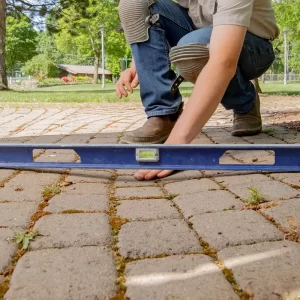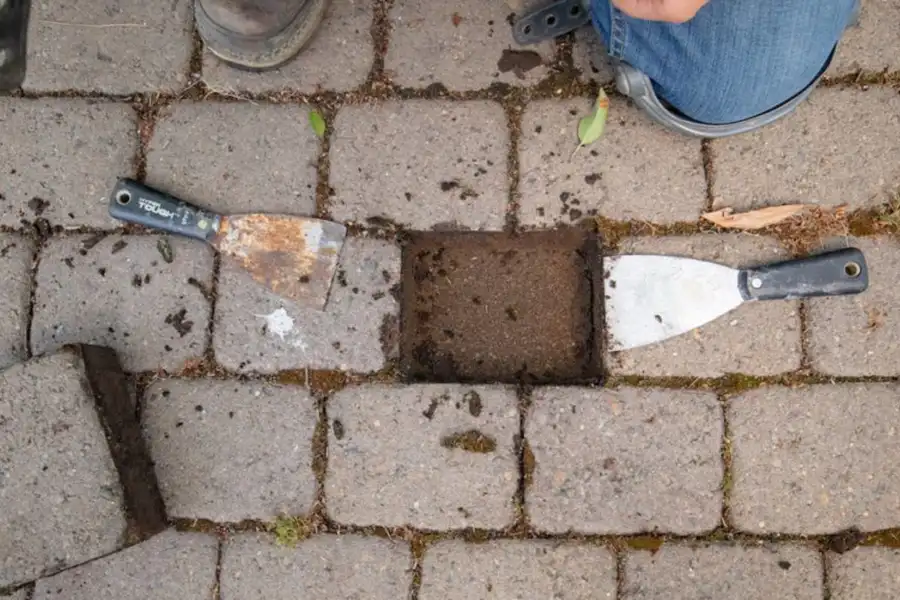Repairing and Replacing Damaged Patio Pavers
Repairing and replacing damaged patio pavers safeguards a safe, attractive outdoor space. Common issues like sinking or loosening often stem from inadequate sand or poor installation. Key tools include a pry bar, rubber mallet, broom, and level. The process involves identifying, lifting, and inspecting the damaged pavers, verifying a level sand base, and installing new pavers. Regular maintenance and proper sealing help prevent future damage. Professional repair services offer expert solutions and quality results. By understanding how to address these issues, homeowners can keep their patios looking great and functionally sound. Discover more detailed steps and essential tips ahead.
Key Points
– Identify and mark damaged pavers for removal and inspection.
– Use a pry bar and rubber mallet to lift and replace faulty pavers.
– Ensure the sand base is level before installing new pavers.
– Regular maintenance and sealing protect pavers from future damage.
– Participate in community workshops for hands-on repair skills and support.
Identifying Patio Paver Issues
How can homeowners quickly spot common issues with their patio pavers? Recognizing problems early is vital to prevent more significant damage. Common issues include sinking, loosening, and crooked pavers, often caused by inadequate sand or poor compaction during installation. Homeowners should regularly examine their patios for these problems, especially after severe weather conditions. Freeze-thaw cycles in winter can lead to pavers cracking or shifting, so checking for any movement or damage is crucial once the weather warms up.
Different paver types, like concrete, brick, or stone, may display problems differently. Concrete pavers may develop cracks, while bricks could become loose and stones may shift. Homeowners can often address these problems with DIY solutions. For example, replacing a damaged paver usually entails removing the affected unit, adding new sand, leveling it, and placing a new paver.
Maintenance suggestions such as sweeping the patio frequently, ensuring proper drainage, and resealing pavers can help alleviate these common issues. Remaining watchful and conducting regular checks after weather events can prolong the patio’s lifespan and preserve its visual appeal. Consistent maintenance and timely repairs are essential for a durable patio.
Tools and Materials Needed
 What necessary tools and materials are required for repairing and replacing damaged patio pavers? To guarantee successful paver maintenance and DIY repairs, having the right tools and materials on hand is essential. Necessary tools include a pry bar, rubber mallet, broom, level, and a wooden float. Each of these plays a significant role in properly lifting and aligning pavers.
What necessary tools and materials are required for repairing and replacing damaged patio pavers? To guarantee successful paver maintenance and DIY repairs, having the right tools and materials on hand is essential. Necessary tools include a pry bar, rubber mallet, broom, level, and a wooden float. Each of these plays a significant role in properly lifting and aligning pavers.
A pry bar helps in removing the damaged paver without disturbing adjacent ones. The rubber mallet is indispensable for tapping new pavers into place, ensuring a snug fit without causing damage. A broom is needed to clear any debris from the repair area, while a level ensures the new paver sits evenly with the surrounding surface. The wooden float is used to compact the sand base, providing a stable foundation for the paver.
In addition to these tools, materials like sand and replacement pavers are essential. Sand is used to fill gaps and level the base, ensuring proper drainage and stability. Replacement pavers should match the existing ones in size and color for a seamless repair. By following these expert advice and proper techniques, anyone can achieve a professional-quality repair.
Steps to Repair Paver Patios
Replacing and repairing damaged paver patios involves a systematic approach to guarantee a smooth and durable repair. First, identify the damaged pavers and mark them for paver removal. Using a pry bar, carefully lift the faulty pavers without disturbing the surrounding ones. Once removed, inspect the underlying sand base for any inconsistencies or debris. It is crucial to add and compact fresh sand to achieve proper paver leveling.
Next, verify the sand base is even using a level. This step is vital as uneven sand can lead to future issues. After achieving a level base, proceed with the new installation by placing the replacement paver into the prepared spot. Use a rubber mallet to gently tap the new paver into place, ensuring it sits flush with the adjacent pavers.
Once the new paver is secure, fill the joints with fine sand. Spread the sand over the area and use a broom to sweep it into the gaps. To finish, wet sand the area to help the sand settle and lock the pavers in place. This systematic approach guarantees the repaired section is as durable and aesthetically pleasing as the original patio.
Benefits of Paver Repairs
Repairing pavers not only enhances the visual appeal of an outdoor space but also increases the property’s value and safety. Improved aesthetics make a significant difference, providing a polished and well-maintained look that can impress visitors and potential buyers alike. This visual upgrade translates directly into increased property value, making the investment in repairs worthwhile.
Enhanced safety is another vital benefit. Damaged or uneven pavers can pose tripping hazards, especially for children and the elderly. Repairing these issues ensures a smooth, safe surface for everyone. Additionally, regular maintenance can extend the longevity of the patio, preventing minor issues from escalating into more significant, costly problems.
When it comes to cost-effective maintenance, addressing paver damage early on is essential. Small repairs are often much less expensive than full replacements, saving money in the long run. Homeowners who stay on top of maintenance tasks can enjoy a beautiful, safe, and valuable patio for years to come. By focusing on these benefits—improved aesthetics, increased value, enhanced safety, longevity benefits, and economically efficient maintenance—individuals can make informed decisions about maintaining their outdoor spaces.
Preventing Future Damage
Maintaining the benefits of repaired pavers requires proactive steps to prevent future damage. First, employing effective sealing techniques is essential. Sealing pavers protects them from stains, moisture infiltration, and wear, thereby extending their lifespan. Regular sealing, typically every few years, guarantees ongoing protection.
Preventive maintenance is another crucial aspect. This includes regularly inspecting the patio for any signs of wear or damage and addressing issues promptly. Small cracks or loose pavers, if left unattended, can lead to more significant problems.
Winter protection is vital, especially in regions with harsh winters. Applying a sealant before the cold season and using de-icing products that are safe for pavers can help mitigate freeze-thaw cycles that cause cracking and displacement.
Drainage solutions are also important in preventing water accumulation, which can weaken the paver foundation. Ensuring proper slope and installing drainage channels can effectively manage water runoff.
Lastly, proper edging is required to keep pavers in place and prevent them from shifting. Installing sturdy edging materials along the perimeter of the patio helps maintain the integrity of the paver installation.
Professional Repair Services
Engaging professional repair services guarantees that paver patios are restored with expertise and precision, addressing issues that DIY fixes might overlook. Professionals use expert techniques to make sure each paver is perfectly placed and secured. Their knowledge extends beyond surface repairs, delving into the underlying causes of damage such as poor compaction or drainage issues.
Quality craftsmanship is a hallmark of professional repair services. Technicians use high-grade materials and tools to secure the longevity and aesthetic appeal of the patio. This level of attention to detail often results in a finish that not only looks better but also lasts longer than a DIY attempt.
Efficient solutions are another significant benefit. Professionals can complete repairs in a fraction of the time it would take an amateur, minimizing disruption to the household. Their experience allows them to quickly identify and rectify problems, making sure the patio is functional and safe.
Customized approaches are tailored to each specific patio, addressing unique issues such as sunken areas or uneven surfaces. This personalized service ensures that every aspect of the patio meets the homeowner’s expectations.
Ultimately, professional repair services offer guaranteed satisfaction, providing peace of mind that the job is done right.
Sharing Repair Knowledge
Sharing repair knowledge empowers homeowners to tackle common patio paver issues with confidence and effectiveness. By understanding DIY repair techniques, individuals can save money and time while maintaining their outdoor spaces. Online repair tutorials offer step-by-step guidance, making it easy to follow along and complete repairs such as fixing paver edging or addressing sunken pavers. These resources often include videos and detailed instructions, which are invaluable for visual learners.
Community repair workshops provide hands-on experience and foster a sense of camaraderie among participants. These workshops allow homeowners to learn from professionals and each other, sharing tips and tricks that make the repair process smoother. Attendees can practice repairing paver edging and sunken pavers under expert supervision, making sure they leave with practical skills.
Engaging in these educational opportunities not only enhances individual capabilities but also strengthens community bonds. When neighbors share repair knowledge, they create a supportive network that can tackle larger projects together. This collective expertise guarantees that patios remain beautiful and functional, enhancing the overall appeal of the neighborhood. With accessible resources and community support, anyone can become proficient in maintaining their patio pavers.







